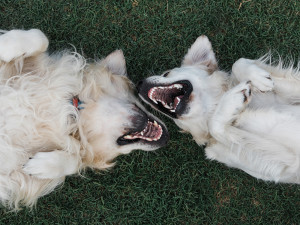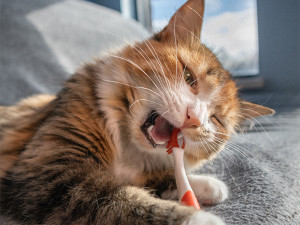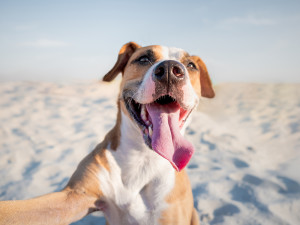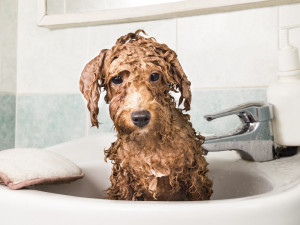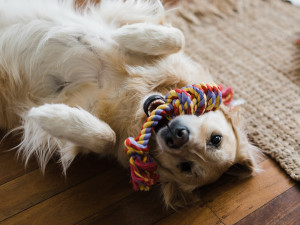Does Your Dog Need a Dentist?
NYC’s top veterinary dentist on bad breath, dental disease, and brushing your dog’s teeth...daily.

share article
Confession: I tried to brush my dog’s teeth just once. She’s a Bulldog with tiny, crooked, crowded teeth. At least when I get a glimpse of them. On the day I tried to brush them, she wouldn’t open her mouth — not when I was holding a torture device, a.k.a. a dog toothbrush, in hand. Not if I stroked her chin, not for peanut butteropens in a new tab, and not, as a last-ditch effort, if I made strange dolphin noises. I couldn’t bear to subject her to it again. Instead, I use an oral additive in her water and hope that’s enough.
So do I even need to try again and brush my dog’s teeth? “The short answer is only the ones you want to save!” Dr. Daniel T. Carmichael, a veterinarian and board-certified veterinary dentist who practices at Animal Medical Centeropens in a new tab in NYC and The Veterinary Medical Center of Long Islandopens in a new tab, tells The Wildest. “But a more complete answer is periodontal disease is the most common disease in dogs, affecting 85 percent over the age of three.” The best treatment is preventing the bacterial plaque from accumulating on your dog’s teeth, and the gold standard is tooth brushing — daily. The next best thing is professional dog teeth cleaning.
How to Brush a Dog’s Teeth
No, you don’t need a special brush — any soft-bristled toothbrush is fine. A breed like a Greyhound might need something longer and a dog like a Pug might benefit from a child’s brush. You don’t really need toothpaste, either. “The brush will do 95 percent of the work,” Dr. Carmichael says. “Most of the toothpaste is nothing more than flavoring.” He recommends looking for products that meet the Veterinary Oral Health Council’s Accepted Products Listopens in a new tab, which have been vetted for effectiveness and safety.
Ideally, start them as puppies or young dogs. “Get them used to the process. As you’re petting them, lift up their lips and look at their teeth,” says Dr. Carmichael, adding that it helps to go slowly and take breaks. Once the outside surfaces of the teeth are exposed, brush them in circular motions. Say you’ve adopted an older dogopens in a new tab — yay! — they may have pre-existing dental issues, sensitivity, or just not be comfortable with a brush in their mouth anytime soon. In that case, go to your vet for an oral examination and potentially a professional dental treatment.
Professional Dental Cleanings for Dogs
Professional dental cleaning requires general anesthesia, which might sound like a lot for a cleaning. “Think about a baby with a mouthful of cavities. We understand that a dental visit is a drag but our poor pets don’t know that — it is kind of torturing them,” says Dr. Carmichael. An average dog teeth cleaning treatment would be a good look and cleaning of all 42 teeth; a periodontal probe to identify area of disease, lesions, tumors, or broken teeth; and a full set of x-rays. The vet will extract any teeth that are severely diseased. Most dogs can get away with one professional dental treatment a year, though it’s totally individual. Small dogsopens in a new tab tend to suffer from more dental problems than larger breeds.
During the dental procedure, your vet will likely perform tooth scaling, to remove plaque and tartar from your dog’s gum and then polish. The way your dog’s breath smells after a teeth cleaning is how fresh your dog’s breath should smell all the time. “Bad breathopens in a new tab is not normal in a dog,” says Dr. Carmichael. “If you notice your dog’s breath is getting worse and it's not from something they ate, it’s dental diseaseopens in a new tab.” For fans of Greenies, they are approved by the VOHC as effective dental treats.
Avoid Products that Injure Dog Teeth
But what is perhaps more important is what to avoid. “I am up to tens of thousands of lost teeth now on account of nylon bones and deer antlers — I can go to a pet store and purchase those in the dental care aisle!” says Dr. Carmichael. Also on the skip list are cow hooves, real bones...basically anything as hard as or harder than a tooth. He recommends sticking with tough rubber toysopens in a new tab like the ones from Kongopens in a new tab. And one more less obvious scourge is a tennis ball. Combine the buzz with sand or grit from dirt and it turns into a grinder that can wear teeth down. “Fetch on a Sunday is fine, but I don't recommend it as a pacifier,” says Dr. Carmichael.
These sobering warnings about dog oral health scared me straight, so I bought a child’s toothbrush and resolved to try brush my bulldog’s teeth again. Not today; she looks so peaceful…but tomorrow.

Marisa Meltzer
Marisa Meltzer has contributed to The New York Times, Vogue, Vanity Fair, and is the author of This Is Big: How the Women Who Founded Weight Watchers Changed the World (and Me). She lives in New York City with her dog Joan.
Related articles
![Cat with a toothbrush]() opens in a new tab
opens in a new tab7 Cat Dental Products You Never Knew You Needed
Vets explain how fish-flavored toothpastes and nifty finger brushes can prevent more than “tooth fur.”
![Dog in the sand smiling at the camera]() opens in a new tab
opens in a new tabCan Dogs Smile?
There’s a big difference between a dog smiling and showing their teeth.
![A dog getting his face scrubbed with soap.]() opens in a new tab
opens in a new tab7 Ways Baking Soda Can Keep Your Dog (And Your House) Clean
This pantry staple is about to become your new secret cleaning weapon.
![Golden Labrador dog laying on its back on the floor with a colorful rope toy in its mouth]() opens in a new tab
opens in a new tab12 Rope Toys Fit For Playful Pups
Two vets on the pros and cons of these canine classics.
